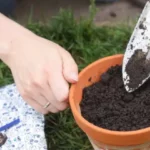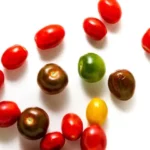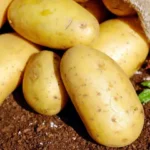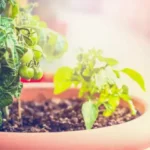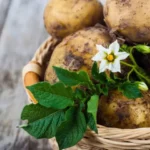Potatoes are a versatile and nutritious staple in many diets worldwide – not to mention a backyard favorite among home growers. Cultivating your own spuds can indeed be a rewarding experience, and even if you don’t have a large garden, you can still enjoy a bountiful harvest by growing potatoes in container.
Grow potatoes in pots or containers in 3 easy steps:
- Cut large seed potatoes into pieces with at least two eyes each for better growth and yield. For smaller seed potatoes, you can sow directly into the soil.
- Seed potatoes should be covered with soil to prevent them from being exposed to sunlight, which can cause them to turn green, bitter, and even poisonous.
- A well-draining potting soil mix with a balanced blend of organic matter, such as compost or aged manure, and perlite or vermiculite for aeration is ideal for growing potatoes in containers. Potatoes grow best in fertile and slightly acidic conditions.
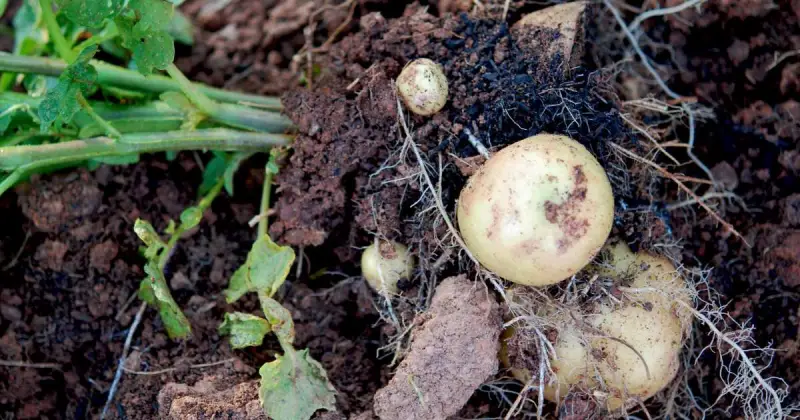
In this article, I will share ways to grow and nurture potatoes in containers, from choosing the correct container to deciding when to harvest and maintaining the perfect potting mix. Remember, growing delicious homegrown crops should be simple, fun, and straightforward. When you finish reading, you’ll know the crucial innovative steps to grow flavorful tubers. Let’s go!
Humble Highlights
- Save time by discovering what size container to select for your potatoes AND how to sow your seed potatoes the right way so you can position your crop for healthier plants and fuller yields – even if you don’t have much space!
- Discover how to water and care for your backyard potatoes (yes, there is a right and wrong way) no matter the size container you choose AND why you should avoid selecting store-bought spuds may cause unnecessary challenges so you can provide exceptional growth for this popular garden favorite.
- Uncover these 3 successful tips any gardener can utilize to help cultivate tasty and bountiful potatoes so you can always have fresh potatoes on demand, ensuring a steady supply of this versatile vegetable for your meals.
How To Plant And Grow Potatoes In A Container
Choosing The Right Container
When it comes to potato cultivation, choosing the correct container is crucial for the success of your plants. Potatoes need a deep container for proper root development, so opt for a large pot or grow bag at least 16 inches deep.
You’ll also want to ensure the container you select has drainage holes at the bottom to prevent pooling water and soggy conditions. Waterlogging can foster disease, weakened plants, and tuber rot – all of which you want to avoid. 1
Preparing Seed Potatoes For Planting
Seed potatoes are small potatoes specifically grown to be re-planted to produce small new and full-sized potatoes. Before planting your spuds indoors or out, prepare your larger seed potatoes by cutting them into pieces, ensuring each piece has at least two eyes or sprouts per piece for healthy growth and better yield. Smaller seed potatoes can be sown directly in the soil without cutting.
Plant the seed potatoes 4-6 inches deep and about 12 inches apart, and cover them with another 3-4 inches of soil. As the potato plants grow, continue to add soil or straw (which acts as a beautiful insulator) around the base of the plants to encourage more tubers to form.
Surprisingly, growing potatoes in containers during winter presents unexpected opportunities. Cultivating these underground treasures in a limited space throughout colder months can be gratifying and enlightening.
Over these colder months of the year, you’ll need to manage soil temperature and composition, fertilization, and watering schedules, which will be crucial as you explore the nuances of container gardening.
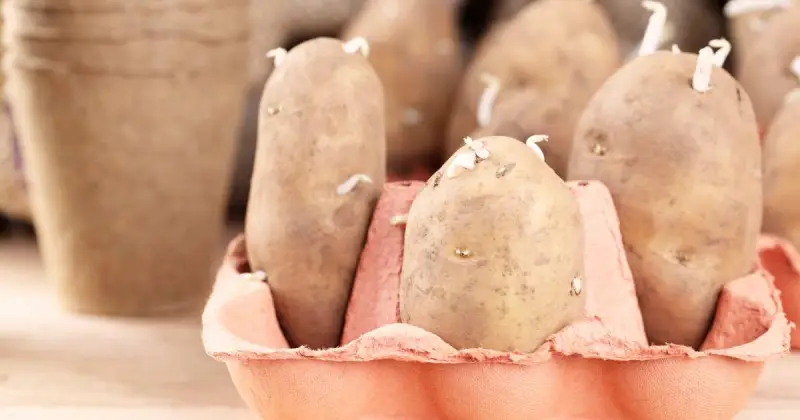
Planting Potatoes In Containers: Step by Step
Fill the container with several inches of potting soil to plant your potatoes. Place the seed potatoes with the eyes facing up in pots, containers, or 5-gallon buckets of your choosing and cover them with 3-4 inches of soil.
As the potato plants grow, add more seed potatoes to the container and more soil to cover the stems of the budding plants, leaving only the top leaves above the soil level. Although some growers choose deeper containers, you should avoid pots taller than 12-18 inches for growing potatoes. These deeper options may make it challenging to harvest your potatoes and potentially cause them to rot if you’re not careful.
Instead, choose containers that are wider rather than taller to provide ample space for the potatoes to grow and to avoid potential issues as they mature.
Watering And Caring For Potatoes: Small And Large Container
Container-grown potatoes need lots of nutrients and care all throughout their growing season. Thus, it is not only important to learn how to grow potatoes, but also how to maintain them properly.
Watering Requirements
Proper watering is essential for growing healthy potatoes in containers, especially indoors. Make sure to keep the soil consistently moist but not soggy. Be sure to water whenever the top inch of the garden soil feels dry to the touch, especially during any hot and dry weather within your region.
Smart pots are an excellent choice for growing potatoes because they are lightweight, eco-friendly, and made of breathable fabric that allows air to circulate around the potatoes as they grow. Additionally, they provide excellent natural drainage, preventing waterlogging and reducing the risk of rot.

Fertilize Your Potatoes
Regular fertilization with a balanced nitrogen, phosphorus, and potassium mix supports potato growth and development. Nitrogen promotes healthy foliage growth, phosphorus supports root development and flowering, and potassium helps to improve overall plant health and disease resistance. 2
A fertilizer with a ratio of 10-10-10 or 15-15-15 is a good potato choice. However, following the package instructions for your chosen fertilizer is essential. You should not over-fertilize, as this can lead to excessive foliage growth at the expense of tuber production.
While it may be tempting to use grocery store potatoes as seed potatoes, it’s important to note that they are not certified to be free from pathogens and are often treated with chemicals to prevent sprouting. They may be more prone to diseases and not produce healthy plants. Therefore, purchasing certified seed potatoes from a reputable supplier is best to ensure a prosperous and healthy yield.
Managing Pests And Diseases In Your Growing Potatoes
Watch for common pests, such as potato beetles, and diseases, like blight. Consider using natural remedies or organic pesticides, such as Neem oil or garlic spray, to protect your plants from potential harm.
Harvesting Potatoes From Containers
Knowing When Potatoes Are Ready
After the potatoes have finished flowering, it’s time to check if they are ready for harvest. You can gently dig around the edges of the container to peek at their sizes. Remember, potatoes can be harvested when they reach the desired size for eating.
- New potatoes are small and immature, harvested at 1-2 inches in diameter with thin skins and a tender texture.
- Baby potatoes are slightly larger, harvested at 2-3 inches in diameter with a firmer texture, and often used in salads and roasted dishes.
- Mature potatoes are fully grown, harvested at 3-5 inches in diameter, and have a firm texture. They are suitable for baking, mashing, and frying.
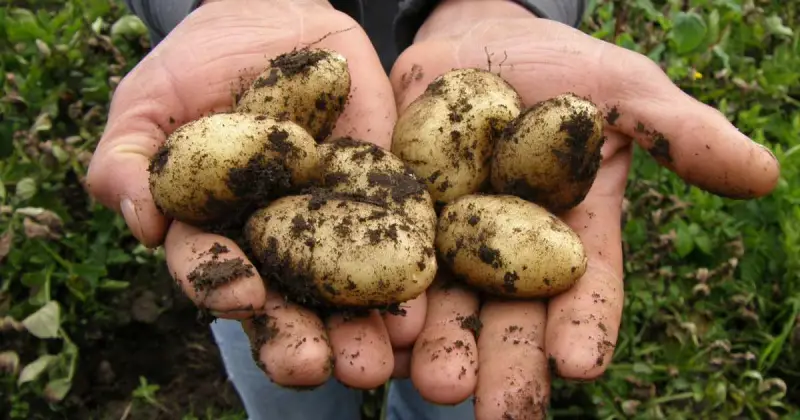
Sift The Number Of Potatoes
Carefully empty the container and sift (separate or sort fine particles from coarse ones) through the soil to collect the tubers (edible underground stems that grow on the potato plant). Be gentle to avoid damaging the potatoes during the process. 3
Storing Harvested Potatoes
Potatoes are ready to be harvested once their foliage turns brown and begins to die back. After harvesting, allow the potatoes to dry out for a day or so to toughen their skin before storing them. Finally, when their skin toughens, rinse your spuds in cold water and store them in a cool, dry, dark place. Use them within the next few weeks for best quality.
Store the potatoes in a cool, dark place with good ventilation to prevent them from sprouting or rotting prematurely. If you wait longer to harvest, the potatoes can be stored longer and are known as ‘storage potatoes.
Want to grow tender and creamy potatoes at home for maximum production without taking up a ton of space? Watch the video below to uncover the insider secrets to cultivating this popular vegetable in containers—you won’t want to go back to store-bought spuds!
Troubleshooting Common Issues In Growing Potatoes In Containers
Addressing Yellowing Leaves On Potato Plants
Yellowing leaves on potato plants can indicate issues such as nutrient deficiencies or overwatering. Adjust your care routine accordingly, ensuring your potatoes receive adequate nutrients and water to maintain healthy foliage.
Dealing With Pests
If you notice pests on several potatoes, consider using natural predators (ladybugs or spinosads) or organic pest control methods (Neem oil or garlic spray) to manage the infestation. This will minimize disruption of the surrounding environment to any beneficial insects. 4
Preventing Diseases In Potatoes Grown In Containers
Home growers have come to understand that there are common challenges to cultivating vegetables, and potatoes are no exception. To decrease the chances of disease among your potato crop, practice good garden hygiene by rotating crops, removing infected plant debris promptly, and ensuring proper air circulation around your plants to discourage fungal diseases.
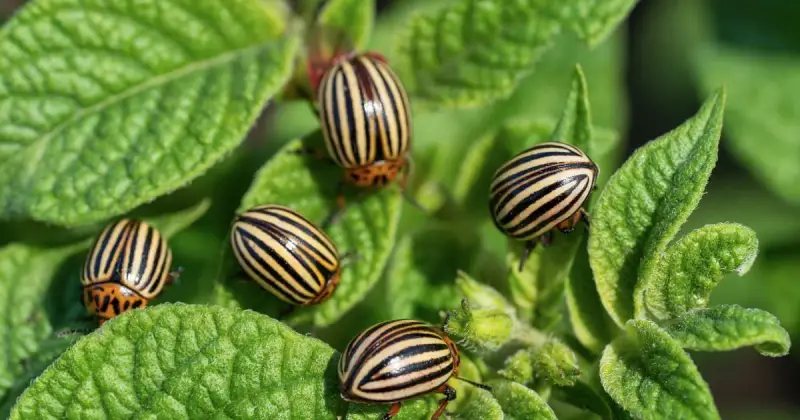
Tips For Successful Potato Growing In Containers
Using The Right Potting Soil Mix
Potatoes require a high-quality potting soil mix specifically formulated for container gardening. This soil mix provides the necessary nutrients and drainage for potatoes to thrive.
To fill your container for growing potatoes, use a mixture of half “soilless” potting mix and half well-rotted compost. This will provide crucial nutrients to your spuds while improving soil quality. 5
It is essential to avoid using fresh manure within your potting mix, as it can harm the plants and potentially introduce pathogens into your garden soil and among your plants. It can also generate too much heat as it breaks down, damaging the young potato plants.
Be sure your manure is aged (mature) for at least six months before adding it to your garden to avoid these issues.
Choosing The Best Location For Your Potato Containers
Place your potato containers in a sunny location with at least 6-8 hours of sunlight daily. Ensure adequate airflow to prevent humidity buildup, which can lead to the proliferation and spread of damaging pests and diseases.
Trash cans are great, especially ones on wheels for growing your potatoes. Just be sure to drill lots of drainage holes in the bottom and a few inches up the sides to prevent waterlogging, which can lead to root rot and other diseases.
Optimizing Sunlight And Temperature For Potato Growth
Potatoes prefer cool growing conditions, with temperatures around 60-70°F (15-21°C). To prevent stress and sunburn, protect your potato plants from extreme heat by providing shade during the hottest parts of the day.
Potatoes are easy to grow and excellent for seasoned and beginning gardeners. Depending on your climate, you can plant the seeds as soon as the soil can be worked in the spring, usually around March or April.
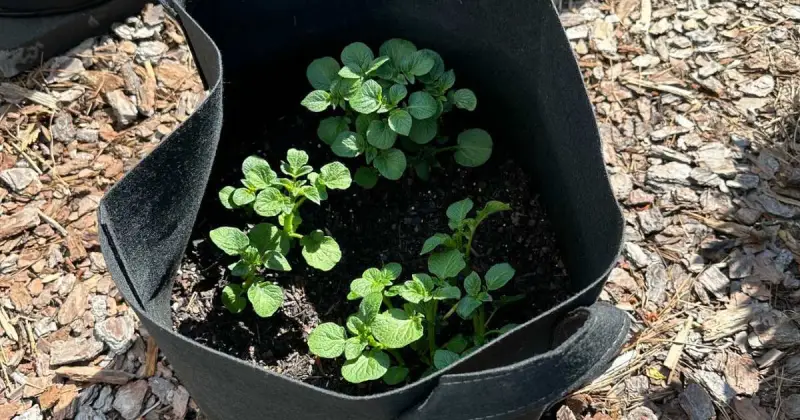
Conclusion
Potatoes can be grown in any container, regardless of the type you intend to plant. This is a rewarding and space-saving way to enjoy a bountiful harvest of this versatile and nutritious crop.
Continue to provide consistent moisture and regular fertilization and monitor for pests and diseases. You can enjoy delicious homegrown potatoes all season long with proper care and attention.
Do you love growing homegrown spuds in containers? We’d love to hear your story and steps to cultivate delicious tubers. Take a few minutes to drop us a line in the comments below and let us in on one or two of your secrets. Also, let us know if you use plastic or cloth bags as your container of choice!
SOURCES
- North Carolina State University, Extension Master Gardener Brunswick County – Growing Potatoes In A Container
- Piedmont Master Gardeners – How To Grow Potatoes
- North Dakota State University, Extension – Potatoes From Garden To Table
- ScienceDirect – Aphids And Their Transmitted Potato Viruses: A Continuous Challenges In Potato Crops
- The University Of Vermont, Extension – Growing Potatoes

